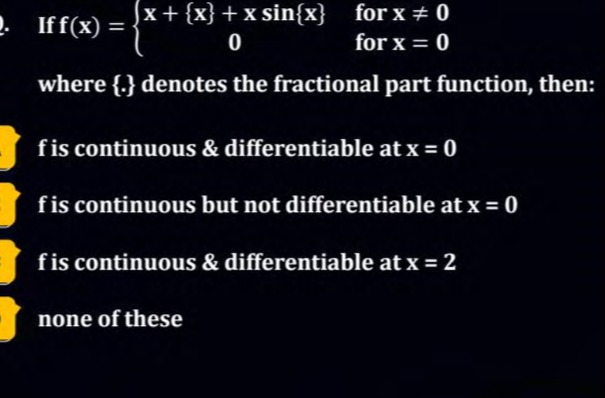Question
Question: If $f(x) = \begin{cases} x + \{x\} + x \sin\{x\} & \text{for } x \neq 0 \\ 0 & \text{for } x = 0 \en...
If f(x)={x+{x}+xsin{x}0for x=0for x=0
where {.} denotes the fractional part function, then:

f is continuous & differentiable at x = 0
f is continuous but not differentiable at x = 0
f is continuous & differentiable at x = 2
none of these
none of these
Solution
The function is given by f(x)=x+{x}+xsin{x} for x=0 and f(0)=0. The fractional part function {x} is defined as x−⌊x⌋.
Continuity at x=0: For continuity at x=0, we require limx→0f(x)=f(0). We are given f(0)=0.
The right-hand limit: As x→0+, ⌊x⌋=0, so {x}=x. limx→0+f(x)=limx→0+(x+x+xsinx)=limx→0+(2x+xsinx)=0 The left-hand limit: As x→0−, ⌊x⌋=−1, so {x}=x−(−1)=x+1. limx→0−f(x)=limx→0−(x+(x+1)+xsin(x+1))=0+(0+1)+0sin(0+1)=1 Since limx→0+f(x)=limx→0−f(x), the limit limx→0f(x) does not exist. Thus, f is not continuous at x=0.
Continuity at x=2: For continuity at x=2, we require limx→2f(x)=f(2). For x=2, ⌊2⌋=2, so {2}=2−2=0. f(2)=2+{2}+2sin{2}=2+0+2sin(0)=2
The right-hand limit: As x→2+, ⌊x⌋=2, so {x}=x−2. limx→2+f(x)=limx→2+(x+(x−2)+xsin(x−2))=2+(2−2)+2sin(2−2)=2+0+0=2 The left-hand limit: As x→2−, ⌊x⌋=1, so {x}=x−1. limx→2−f(x)=limx→2−(x+(x−1)+xsin(x−1))=2+(2−1)+2sin(2−1)=2+1+2sin(1)=3+2sin(1) Since limx→2−f(x)=3+2sin(1)=f(2)=2, f is not continuous at x=2.
Since f is not continuous at x=0 and x=2, the first three options are false. The correct option is none of these.
